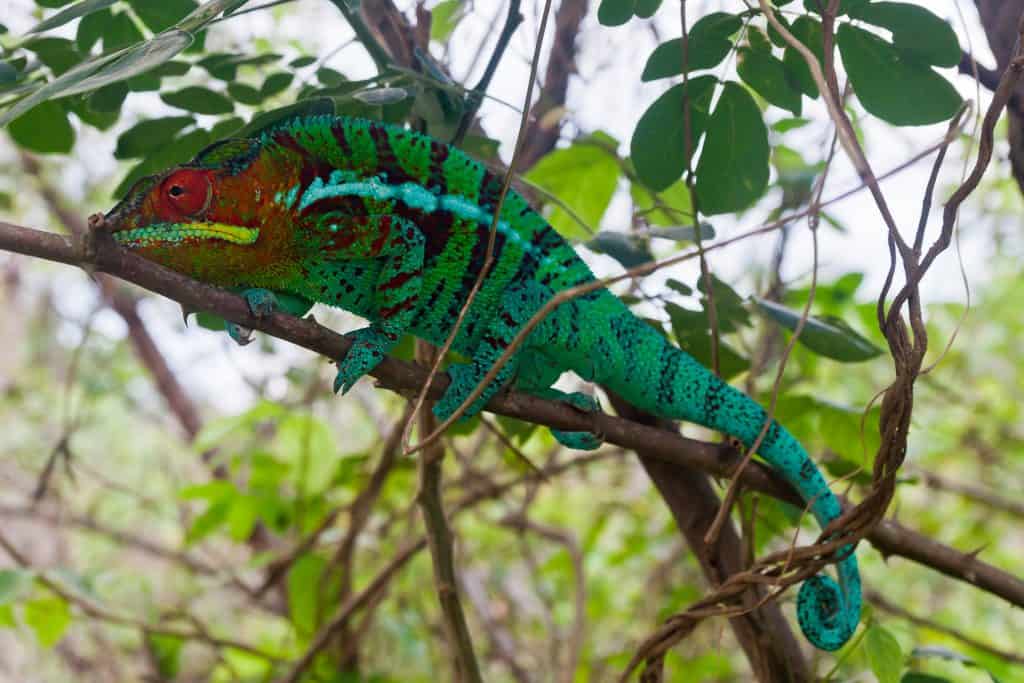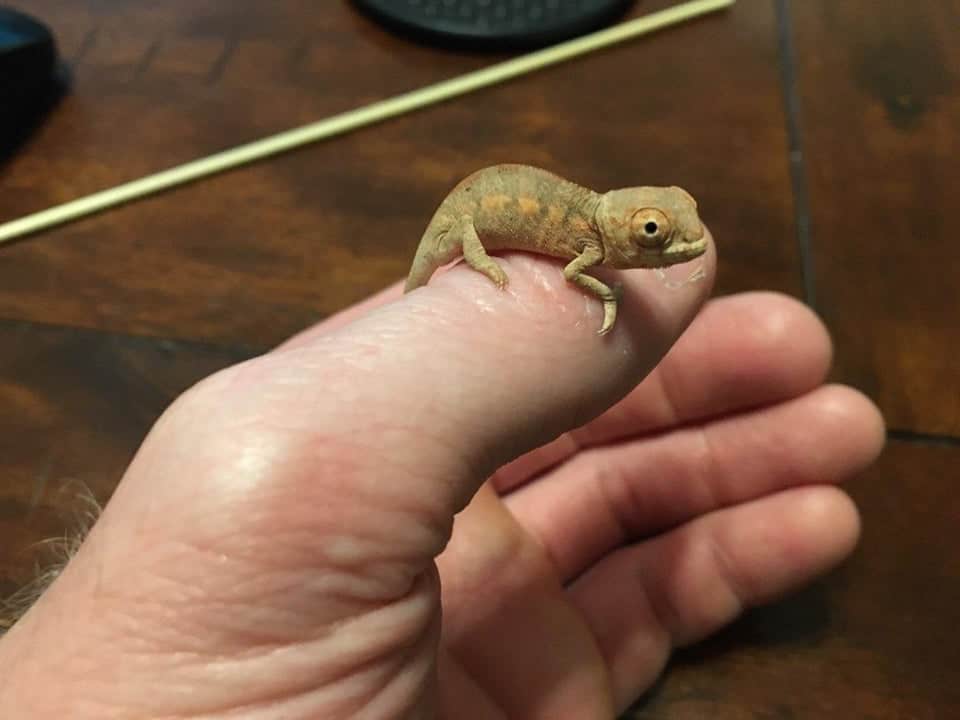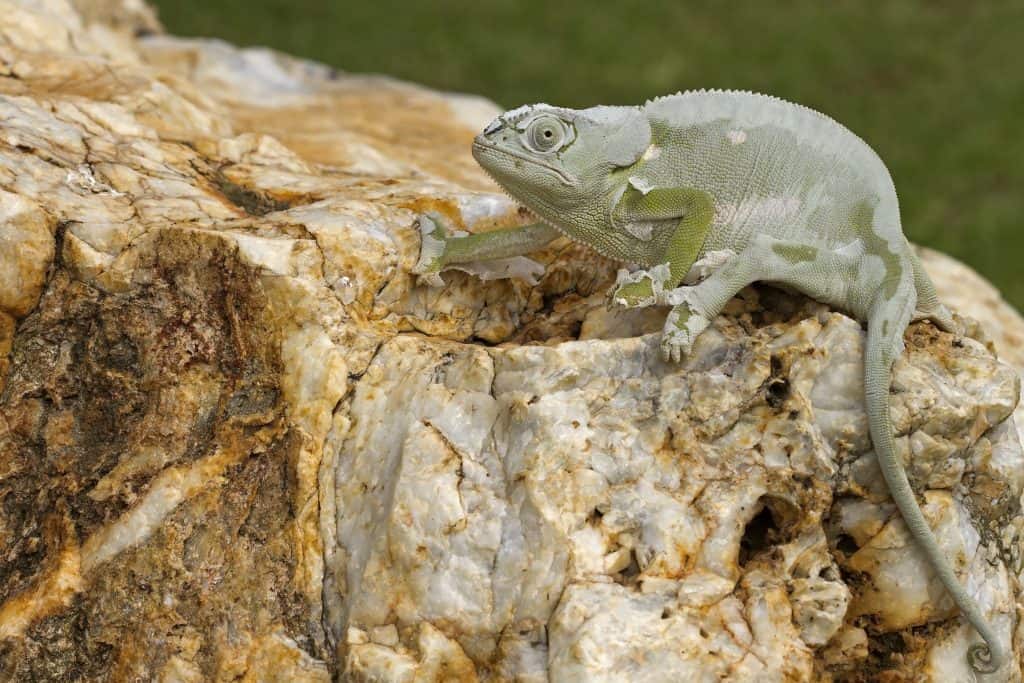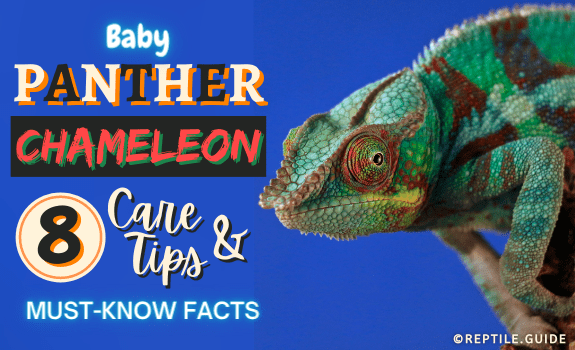Panther chameleons are alluring pets, thanks to their colors, availability, and small size. Who wouldn’t want to own a living rainbow?
As popular as they are, chameleons are one of the most challenging reptiles to raise. Babies, especially, are fragile and die easily.
You must have the commitment and a thorough understanding of their care requirements if you plan on successfully raising a baby. Keep reading to learn how.
In This Article
1. What to Know BEFORE You Buy a Baby Panther Chameleon
- Baby chameleons are fragile and finicky. They’re difficult for beginners to care for.
- Chameleons are a “look but don’t touch” pet. You should only handle them when absolutely necessary.
- Baby chameleons that survive grow into adults that require large enclosures and expensive equipment.
- If you don’t know what you’re doing (and even if you do!), there’s a high chance your baby panther chameleon will die.
- Since panther chameleons are illegal to import from the wild, you can only buy captive-bred babies. They’re usually healthier but significantly pricier than wild-caught chameleons.
2. Natural History and Description of Panther Chameleons
Panther chameleons (Furcifer pardalis) are native to northern and eastern Madagascar. They’re at home high in the branches of tropical forests.

They’re among the most colorful chameleon species. Individuals from different regions are known for their distinct colors:
- Nosy Be – Mostly blue with faded blue stripes and red dots.
- Ankify – Green with turquoise bars, orange eyes, and light blue lateral lines.
- Ambanja – Blue with red or blue bars and turquoise lateral lines.
- Ambilobe
- Blue Bars – Green with blue bars, a turquoise lateral line, red eyes, and a yellow underside.
- Red Bars – Green with red bars, red eyes, white mouths, orange undersides, and a powder blue lateral line.
- Antsiranana – Greenish yellow with maroon bars, light blue or white lateral lines, and yellow undersides.
- Sambava – Green with maroon bars, yellow undersides, and powder blue or white lateral lines.
- Maroantsetra – Red and green with maroon bars, white lateral lines, and orange undersides.
- Tamatave – Red or orange with white spots and white lateral lines.
- And many more!
Adults grow up to twenty inches in length, with males being noticeably larger. Boy chameleons are noticeably more colorful than the girls.
Compared to other reptiles, a panther chameleon’s life is condensed. They reach sexual maturity between six and twelve months.
Males only live for five to seven years.
Females have an even shorter lifespan, thanks to the arduous process of producing and laying eggs. The girls rarely live longer than their third birthday.
Panther chameleons are famous for some of their physical survival adaptations:
- Long, sticky tongues that launch out to catch prey
- Independently moving, telescopic eyes for locating prey
- Specialized feet adapted for gripping small tree branches
- Ability to change colors based on temperature, mood, and lighting
As with other chameleons, Panther chameleons possess rounded pupils which allow for plenty of light to enter their eyes. This makes hunting much easier.
If you want to learn more about how chameleons and other reptiles see the world, check out our reptile vision guide.
Most chameleons are colorful and fragile, but panther chameleons are one of the most colorful and least fragile species. Preferred and successful care techniques are well documented by researchers.
Panther chameleons make great pets for committed and knowledgeable owners.
Did You Know? There are more than 4,700 species of lizards in the world. Around 171 of them are chameleons.
3. Baby Panther Chameleons Are Challenging to Raise
Most baby chameleons in captivity don’t make it to adulthood.
Even experienced reptile keepers know they may very well lose some of their babies, even with the best care.
It’s challenging to provide the precise temperature, humidity, diet, and surroundings that this species requires. Just like in nature, it comes down to “survival of the fittest.”
Stress and dehydration are the primary causes of death for any baby chameleon.
Stress
Baby chameleons are easily stressed. Some stressors are unavoidable, while uneducated owners, unfortunately, exasperate others.
If you’re getting a baby chameleon, be mindful of minimizing the following stressful conditions:
- Poor diet
- Low humidity
- Improper lighting
- Excessive handling
- Inadequate airflow
- Environmental pathogens
- Dangerously high or low temperatures
- Constant environmental fluctuations, including:
- Transportation or shipping
- Unstable temperature, humidity, or lighting schedule
- Movement and activity of people or pets in the same room as the enclosure
A chameleon that’s stressed may hiss, open its mouth, or change to a darker color.
Dehydration
Panther chameleons don’t drink from a water dish AT ALL. They only drink water from droplets on plants and other surfaces.
Even chameleons that are drinking sufficiently will become dehydrated in a dry environment. The humidity level must remain between 60% and 80%.
Plants are essential for holding water droplets and raising the humidity level in the habitat. They also offer great climbing and hiding opportunities.
To complicate matters, panther chameleons must live in a mesh cage. It’s challenging to maintain high humidity in mesh chameleon cages.
Handling
When most animal lovers acquire a pet, they look forward to handling it. Unfortunately, frequent handling isn’t an option with panther chameleons.
Particularly as babies, they’re incredibly fragile, nervous, and prone to dying from stress.
Instead, try to interact and bond with your pet by hand-feeding it. Misting times are also a perfect opportunity for bonding and appreciating your chameleon for what it is.
It’s permissible to handle your chameleon when you’re weighing it, cleaning its habitat, or need to take it to the veterinarian.
Your cham may be more comfortable if you remove and carry the branch that it’s already perched on. Moving the perch is less stressful than attempting to corral the lizard onto your hand.
As your panther chameleon grows older, stronger, and more comfortable with your presence, you may begin to handle it. The best practice is to wait until it’s at least six to nine months old.
Some individuals never grow accustomed to handling. It’s critical to accept this fact before you get a chameleon. Nothing’s more disappointing than unmet expectations!
4. Baby Panther Chameleons Are Expensive
Panther chameleons usually cost over $200. Rare localities may cost even more than that – as much as $1,000!
All panther chameleons for sale are most likely captive-bred. Collecting this species from the wild is currently illegal. That’s why they’re so expensive.
Many chameleon species have similar CITES protections, but people may collect them from wild populations in habitats outside of their natural range.
Jackson’s chameleons are an established, non-native species in Hawaii. Veiled chameleons are an established, non-native species in Florida.
Non-native chameleons that are removed from the environment are sold relatively cheap, often less than $100.
There are no established, wild populations of panther chameleons in the United States. Dedicated captive breeders produce all animals in the pet trade.
Are you interested in a more affordable, established, wild-caught chameleon? Check out this list of beginner-friendly chameleon species.
While they have a higher initial cost, captive-bred animals are remarkably healthier and less stressed.
Buy captive-bred can save you a ton of money on veterinary bills or buying a chameleon that ends up dying from the stress of importation.
5. Baby Panther Chameleons Need a Tall Enclosure
Baby chameleons need an enclosure that’s at least 30″ tall. If they can’t climb, they’ll feel vulnerable and stressed. Cage height is more important than length.
Once your baby panther chameleon grows up, it will need an enclosure that’s at least 36″ tall.
These are just minimum guidelines for an enclosure size! Bigger is always better (for adults). There are even plans for large, DIY, chameleon-friendly cages.
While your chameleon is young and vulnerable, keep it in a small chameleon cage to monitor its health.
It’s easier to densely decorate a small habitat. For now, lots of leaf cover is more important than lots of empty space. A cluttered living area will help your baby chameleon feel hidden and safe.
Dimensions
Minimum Enclosure Dimensions (Baby): 16″ x 16″ x 30″
Minimum Enclosure Dimensions (Adult): 24″ x 24″ x 36″
Substrate
Part of setting up your pet chameleon cage is selecting a suitable substrate.
If you use potted plants, you could leave the bottom of the cage empty. If you’re watching out for parasites or stool frequency, try a paper towel.
Some chameleon keepers consider a homemade topsoil mix to be the superior substrate choice. This natural substrate will help you maintain higher humidity levels and add living plants.
Avoid soil mixtures with added fertilizers or pesticides. Avoid reptile carpet, too.
6. Baby Panther Chameleons Require a Specialized Set-up
We’ve covered cage height…
We’ve covered misting and humidity needs…
That has to be it, right?!
Wrong.
Panther chameleons require lighting and heating on their cage. They also need branches, plants, and decor. Without those products, they won’t survive.
Without proper heat, your panther chameleon’s body will gradually shut down. It won’t be able to digest food, and its immune system will become compromised. All reptiles need to thermoregulate for their health and wellbeing.
Without proper light, your pet chameleon won’t know where to go for heat. It will also face vitamin deficiencies and diseases like MBD (Metabolic Bone Disease).
These animals need UVB to synthesize vitamin D3. Low vitamin D3 levels lead to insufficient calcium absorption. Low calcium levels weaken and even deform the lizard’s skeleton, eventually resulting in death.
Lighting
UVB Light Schedule: 10-12 Hours Light/12-14 Hours Dark
UVB has many benefits outside of vitamin D3 production. Chameleons can even see UV light as an entirely new color. Scientists have thoroughly studied the benefits of UVB for ALL reptiles.
Use a high-output UVB bulb when your chameleon is a baby, like a 10.0 UVB. You can bump down to a 5.0 UVB bulb when your chameleon reaches adulthood.
Replace the bulb every six to twelve months, even if it’s still emitting visible light.
Follow manufacturer guidelines for mounting distance and replacement frequency.
Heating
Ideal Basking Temperature: 85-90°F
Ideal Ambient Temperature: 75-80°F
Ideal Nighttime Temperature: 70-75°F
You can use any overhead heater for a panther chameleon. Popular options include:
- Deep heat projector
- Ceramic heat emitter
- Incandescent lightbulb
Run the heating element on a dimmer or thermostat to ensure that the hottest spot in the chameleon cage doesn’t surpass 90°F.
Alternatively, you can fiddle with a laser thermometer and heat lamp stand. Adjust the distance of the lamp from the cage until your temp gun reads the perfect temperature.
You must position your heat source the same way as the UVB lighting. Panther chameleons are hardwired to seek bright lights when they need heat.
Decor
Decor is so much more than junk to make a terrarium look pretty! These decorative items are essential for your chameleon to:
- Drink off of
- Feel hidden and safe
- Climb high in the cage
- Bask near the heat and light
- Experience various textures, scents, and colors
Place branches and plants in such a way that your chameleon can climb vertically and horizontally.
Branches should be of varying thicknesses. The variety is essential for healthy foot muscle development.
You shouldn’t see much empty space in your chameleon’s terrarium. Fill in as much as you can with leafy plants, vines, and sticks. Chameleons don’t like to feel exposed.
If you’re not sure what plants to use, here’s a handy list of reptile-safe greenery.
Cohabitation
If you’re thinking of cohabitating panther chameleons, please don’t!
Like most chameleons, these animals are fiercely territorial. They probably won’t kill each other, but they’ll never stop fighting. The ongoing stress is sure to lead to an early grave.
You should only house hatchlings communally and only in the first few weeks of life.
7. Baby Panther Chameleons Eat Live Bugs
If the idea of housing and handling live creepy crawlies scares you, a baby chameleon is NOT the right pet for you!
Baby chameleons require live bugs – and they need a variety of them.
You’ll need to dust the insects with vitamins before adding them to the cage.
You’ll also need to temporarily house some – unless you plan on buying bugs from the store every day!
Bug escapes are to be expected, too. Not to mention the smells and noises that come from some feeder insects.
You’ll need to be comfortable with all of this if you want to own a chameleon.
What to Feed Them
Here’s a list of the BEST feeder insects for your chameleon:
- Ants
- Snails
- Crickets
- Roaches
- Fruit flies
- Butterflies
- Silkworms
- Waxworms
- Mealworms
- Safe spiders
- Hornworms
- Earthworms
- Superworms
- Hawkmoths
- Grasshoppers
- Black soldier fly larvae
The right food for your baby chameleon is any food that it will eat. Baby chameleons can be picky little creatures. Still, encourage and introduce as much variety as possible.
Vitamin deficiencies are one of the most prevalent issues with baby chameleons. These lizards are particularly prone to vitamin A deficiency and calcium deficiency. A varied diet will help you cover your bases.
The insects should be no larger than the space between your baby chameleon’s eyes.
At first, your best bet is pinhead crickets, flightless fruit flies, and the youngest roach nymphs.
Supplementation
It’s crucial to gut load the insects for 24 hours before feeding them. Feed fresh vegetables that are rich in calcium and vitamin A to crickets, roaches, and other applicable bugs.
Dust all feeder insects with vitamin or mineral powders. Try the following schedule, and adjust it as needed:
- Calcium without vitamin d: Daily
- Calcium with vitamin d: 2x/month
- Reptile multivitamin: 2x/month
How to Feed Them
Some chameleon owners prefer to feed insects off a tong. Tong feeding is excellent for preventing escaped bugs and monitoring how much your baby chameleon is eating.
Unfortunately, we don’t live in a perfect world. Some baby chameleons are too shy to eat off tongs in your presence. With practice, you may develop that level of trust with your pet.
Until then, try hand-feeding all of the insects in a cup. The cup contains them without blocking your chameleon’s line of sight – or projectile tongue.
Baby chameleons should have constant access to live feeder insects until they reach 12 months old. Most baby chameleons will eat 10-15 appropriately-sized insects per day.
Water
Your panther chameleon will only drink water drops off branches, plants, and other surfaces in the cage.
Most chameleon keepers opt to install a water drip system. These systems tend to be complicated, but they give your chameleon a constant supply of fresh water.
Whether or not you install a dripper, you’ll need to spray your chameleon’s cage at least three times a day.
Be sure to spray the sides, branches, and plants. The more water drops, the better. The droplets are the only water source your chameleon is interested in.
8. Baby Panther Chameleons Grow Fast
You can expect your panther chameleon to grow up to 20 inches as an adult. Males grow larger (and faster) than females. The surprising part is how quickly they reach such lengths!

A healthy, well-cared-for baby chameleon will grow one to two inches per month.
By 12 months old, your panther chameleon should be full-sized.
Growth Chart
|
Hatchling |
2” |
|
2 Weeks |
3” |
|
1 Month |
5” |
|
3 Months |
7” |
|
8 Months |
7-14” |
|
12 Months |
8-20” |
Adulthood
Adult Female Panther Chameleon Size: 8-14″
Adult Male Panther Chameleon Size: 12-20″
9. Baby Panther Chameleons Shed Their Skin
Like most reptiles, your panther chameleon will periodically shed its skin.
Shedding is helpful for physical growth, healing wounds, and removing parasites.
When lizards are going into shed, their color becomes dark and drab.

Eventually, their skin will start to shed off. It usually comes off in pieces or flakes.
Sometimes, lizards will eat their old skin for a nutrient boost. This behavior is more common in babies than adults.
Frequency
Juveniles (<12 Months): Every 2-4 weeks
Adults (>12 Months): Every 4-8 weeks
How to Help
Do everything you can to boost the humidity when your panther chameleon is getting ready to shed.
Try spraying the habitat four to six times a day, and spray some of the water directly on the chameleon.
If that doesn’t work, shower your chameleon. The water should feel lukewarm to you – no more than 85°F. Point the showerhead at the wall and allow the droplets that bounce off the wall to fall on your chameleon.
As a last resort, you can gently rub stuck-on pieces with a moistened cotton swab.
Panther Chameleons: Challenge Accepted
If you found these care factoids interesting and exciting, rather than intimidating, maybe panther chameleon ownership is right up your alley!
We urge you to take the time to review in-depth guides about panther chameleon care requirements before taking the big step.
